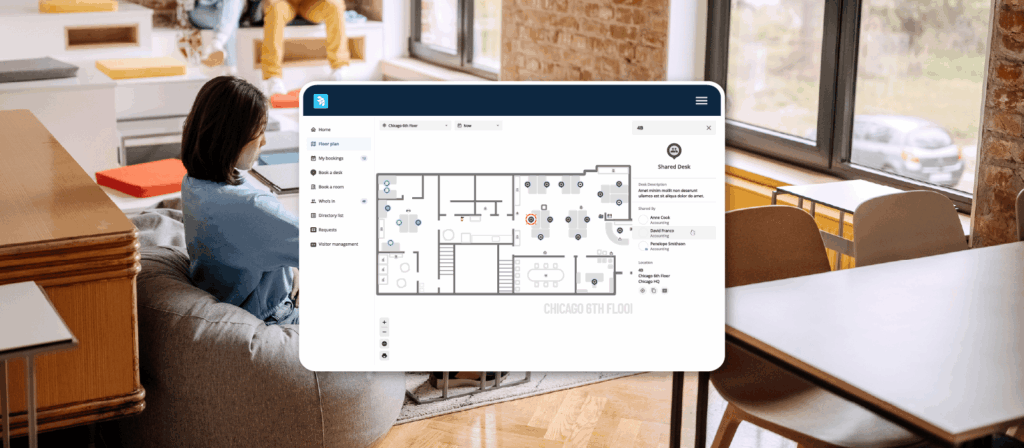Effective facility management requires managers to understand their space across multiple dimensions. A facility manager’s day is filled with tasks and duties that are vital to the successful operation of an organization. Among these responsibilities is ensuring the optimization of office space and resources.
Everything from energy usage to employee sentiment is affected by the facility—and facility managers (FMs) play an important part in making key decisions about these operations. Tracking analytics can help alleviate the pressure managers face by providing valuable data and a more objective basis for decision making. This data can provide insights to FMs about their facilities, allowing for informed and effective changes that can save money while increasing sustainability and productivity. Let’s take a look at different analytics that facility managers should track.
Space utilization

Facility managers need to make sure that the company is maximizing the value of the office’s physical space. One way to do this is to look at the office’s space utilization rate, which measures the percentage of total office space that is actively used. Identifying dead space and sketching out different floor plan scenarios can help to create an office that reflects employees’ preferences without wasting resources and space.
Unused or underused spaces create unnecessary expenses and lost opportunities for revenue. Measuring the use of space in a facility requires a strategic and versatile approach, as there are multiple data points to consider—including the use of meeting rooms and occupancy rates of seats in the office. FMs can use comprehensive reports and analytics to gauge how their workplace is being used without requiring heavy investments of time.
Tracking space usage by department can help you understand which groups are making the most effective use of their space—you can then make adjustments accordingly. These reports are also helpful in understanding whether your space is appropriate for the number of staff and resources you have on hand, or whether it’s filling up faster than you planned for. Additionally, by reporting on space usage by square footage, FMs can clearly illustrate the numbers behind an operation and accurately bill back clients.
The more information you have at your fingertips, the more effective you can be as a facility manager. Understanding and making use of the valuable information in these reports will allow you to increase your company’s cost savings and help come in under budget every year. Any facility management software worth its salt should be able to adapt to the varying needs of various organizations, as company-specific data is key to the efficiency of any workplace, regardless of industry or objectives.
Request volumes and response times
Managing requests from employees can be a full-time task. Tracking how much time it takes to manage a request will help you to identify issues with the request management process. A request management system can give you real-time statistics on the average length of time it takes to complete a request.
Look for trends by request type, requester, and department, and identify if there are certain times of the week or month where requests take longer than average to resolve. If there are certain departments where the average resolution time is greater than normal, this may indicate that higher level changes are needed and that more attention and resources should be devoted to these areas. Tracking and observing the average resolution time for requests can help you to identify bottleneck periods and overcome them
Request frequency
Similar to tracking the average time from facility request to resolution, it is also helpful to evaluate request frequencies over time. Look at request trends over a weekly, monthly, and yearly basis to identify peak seasons or periods for requests. Do you see an uptick right before a long weekend? Do more requests come in on Mondays than Fridays?
Looking at the frequency of requests can also help to identify where and when resources might be running low. For instance, you may find that more flex desks are occupied at the beginning of the week, or that you need to restock printer ink before the end of the week. Tracking these patterns can help you to fix problems before requests are made and assist with your staffing and shift-planning decisions.
High request volumes can help pinpoint issues like the need to invest in amenities. Response times are also important for measuring the efficiency of a facility management team. Tracking these metrics helps managers properly delegate work to their team, calculate the cost of contractors, and anticipate future issues like equipment failure or high demand for room bookings. It can be especially helpful to compare request data to industry benchmarks in order to better understand the effectiveness of your office’s request system.
Energy usage

Energy consumption is an important metric to track, as it can affect operational costs and sustainability initiatives and certifications. Managers should consider tracking energy usage in specific areas of the office to pinpoint opportunities to reduce consumption. This data helps to identify exactly where energy use can be optimized without sacrificing comfort or productivity. It can also help companies work with environmental compliance officers or bring valuable evidence to their environmental initiatives.
Utility cost is another commonly-used metric in facility management. If you’re looking to save money on utilities, consider leveraging the power of your building automation system (BAS) to track energy consumption and utility cost. Consider investing in energy-efficient appliances and implementing energy-saving policies, like shutting down computers and printers at the end of each workday. You can also use sensors to detect occupancy and more, which allows a facility manager to have the BAS shut down parts of the building that aren’t in use. Setting a goal for utility consumption and getting all departments on board can help the office cut back on unnecessary waste and spending, but tracking analytics through a BAS or IWMS will provide a higher level of accuracy and savings.
Department and floor occupancy
Tracking occupancy rates in the building on a granular level comes with a number of tangible benefits for FMs. Gauging a building’s occupancy by floor can provide crucial data points to help make major real estate choices like expanding the office or investing in renovations for a specific area.
Managers that are looking for a better understanding of office dynamics and staff behavior should also consider tracking occupancy by department.
Each department will differ in how they occupy a space, and analyzing the data around this behavior can be helpful in many areas, from deciding on future investments to shaping office policies. Are the teams that you expect to occupy their space regularly spending less time at their desks? Perhaps their office equipment is not optimized for their needs or their space is not appropriate for the type of work they need to get done. Understanding nuances like these can help you justify major office changes or allocation of resources using more than just intuition. Quantified data also helps managers track the impact of their decisions after they’re made, which allows companies to avoid unnecessary risks and costly mistakes in the future.
Having accurate and up-to-date data about occupancy of desks and meeting spaces is critical to facility managers, because under using or overcrowding a space can have major consequences. For example, imagine the desks around your office are 90% full but the company is growing at a rapid pace—the facility will soon reach capacity, which means you will soon need to find a bigger space. On the other hand, finding out your space sits at 66% occupancy suggests your space is being poorly utilized, and that valuable dollars are being wasted on real estate. With this information, FMs can make critical business decisions, such as implementing hot desking in the office, to make the most of extra space. Filling seats to an optimal percentage is no easy feat and requires delicate balancing—and through real-time occupancy reports FMs can keep this balance in check.
Resources
For facility managers everywhere, tracking and maintaining resources is a major responsibility. Resource reports help simplify everyday operations by offering a consolidated place to look up equipment assignments or locate necessities, such as important medical or safety items. As staff leave the company or are hired, resource reports can keep FMs informed of the tools available at desk areas. This information is also crucial for situations in which technologies need to be repaired or staffing changes are on the rise. For instance, if a particular phone in the office is broken, resource reports will ensure you don’t waste time tracking the phone down, but will be able to quickly and easily send maintenance to the correct desk. In short, using an automated reporting system will ensure you’re prepared for every situation.
Feedback
Facility management teams work to serve their company to the best of their abilities, which can be complicated due to ever-changing employee needs. Tracking end user complaints can help you realize where office procedures can be fixed or streamlined for optimal productivity. For example, if you’re using outdated spreadsheets or PDFs for your office floor plan, you may receive a number of complaints that these files are out of date. Similarly, if visitors are often getting lost in the office or commenting on their inability to find their destination, your office wayfinding may need to be fixed. Tracking the specific types of complaints you most commonly receive can help you to determine priorities, like providing employees with wayfinding software, real-time floor plan updates or visual directories.
Office allocation
As an FM, you play a role in assigning employees desk and office areas. So, how do you set this process in motion? Do you simply assign new employees to any available spot? Or do you consider the entire team and how you can re-assign seats to smoothly integrate new team members into a space? For example, desks with a view or beside a window are coveted in any organization, and it’s common courtesy to assign these to employees with seniority. By running an allocation report, FMs can see the bigger picture within departments and assign seats to show long-standing employees the support they deserve. The same goes for assigning individual offices to middle and senior managers—allocation reports will highlight details such as square footage, so you can ensure top-level employees are working their way up, rather than down. Using these reports in conjunction with a visual directory will enable FMs to make sure desks and space are assigned as appropriately as possible to keep all employees happy.
The role of communication in facility management

Lack of information updates between departments is a common occurrence in many offices. Teams like human resources and facility management may not communicate daily—and this can lead to internal discrepancies. For example, employees may no longer be working at the company but are still registered in the internal directory. In this case, a “seated but deleted” report allows FMs to track desks that appear to be taken, but have actually been vacated by a departing staff member. Managers across different departments can help reduce information errors by using software to communicate and make updates.
The importance of data in office efficiency
Tracking analytics in the office is a crucial part of avoiding emergency situations and optimizing efficiency. Managers that can effectively track and interpret information will be able to address problems with more specific solutions and draw insights that are nearly impossible through human intuition and observation.
While facility managers can track productivity levels with analytics and reports, they must first create an environment that encourages employees to be productive. Learn how tech campuses are making this happen.
Photos: Shutterstock / Jacob Lund, Shutterstock / LStockStudio, Shutterstock / Shebeko, Shutterstock / LStockStudio





